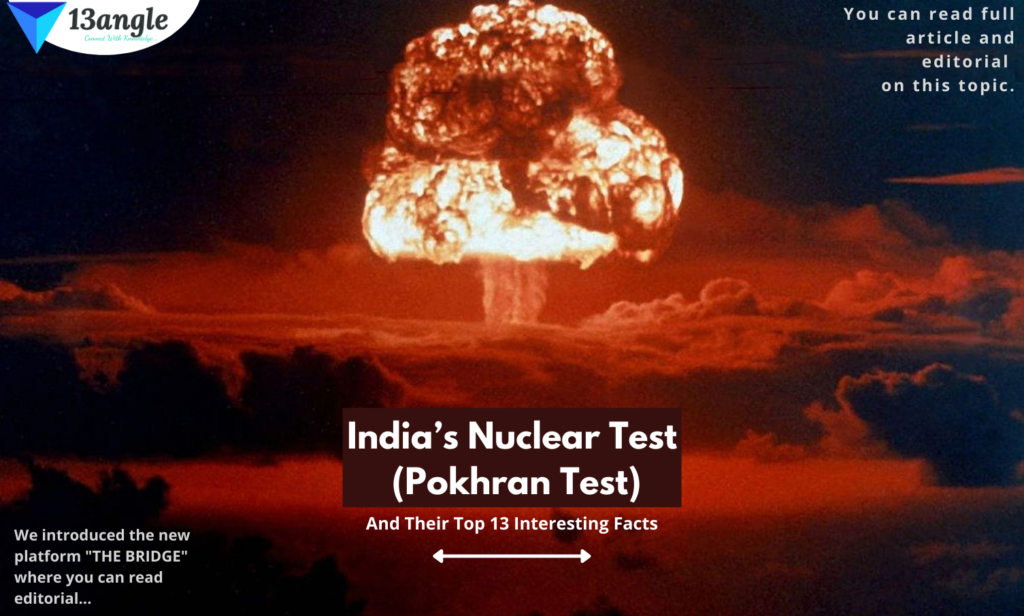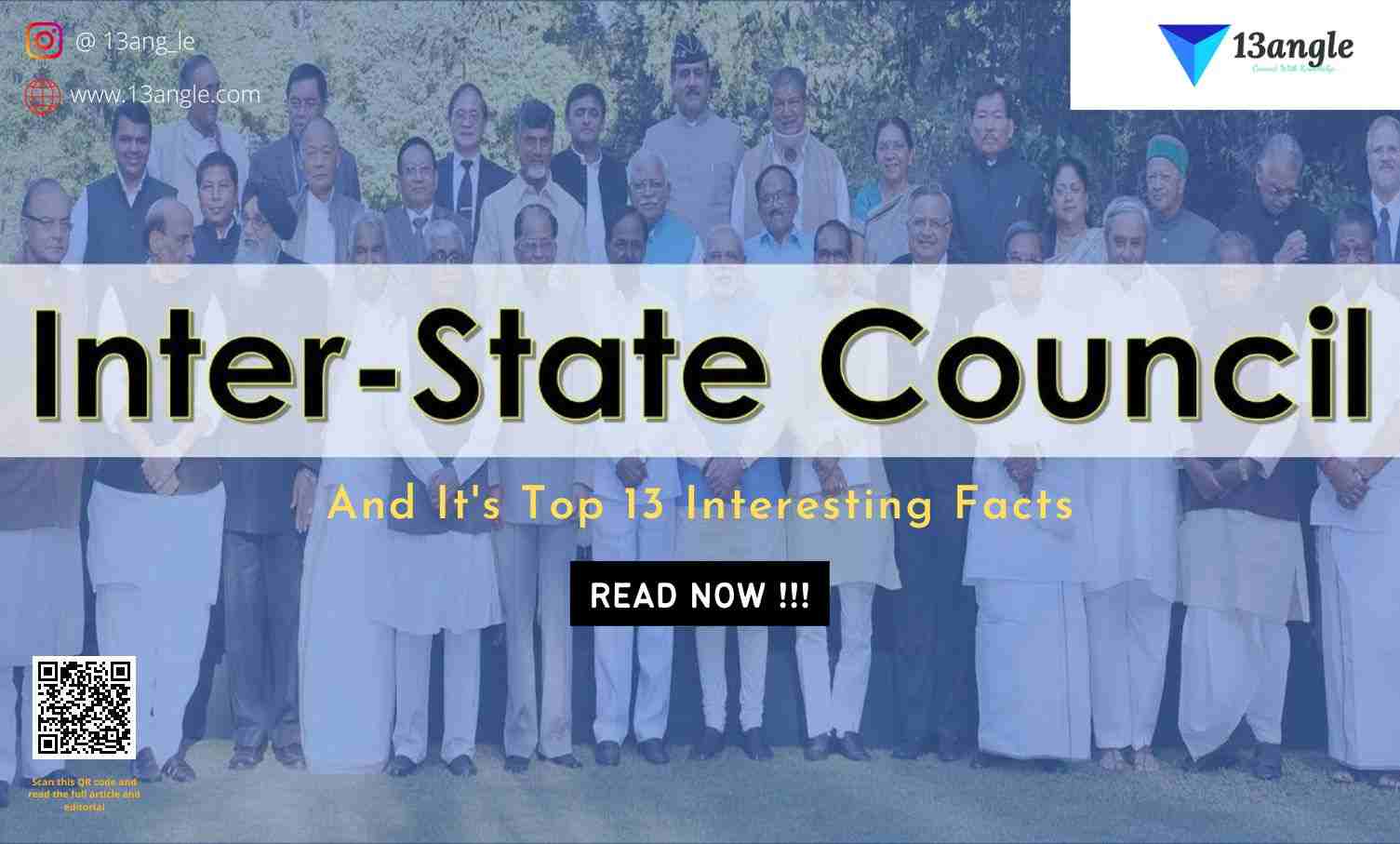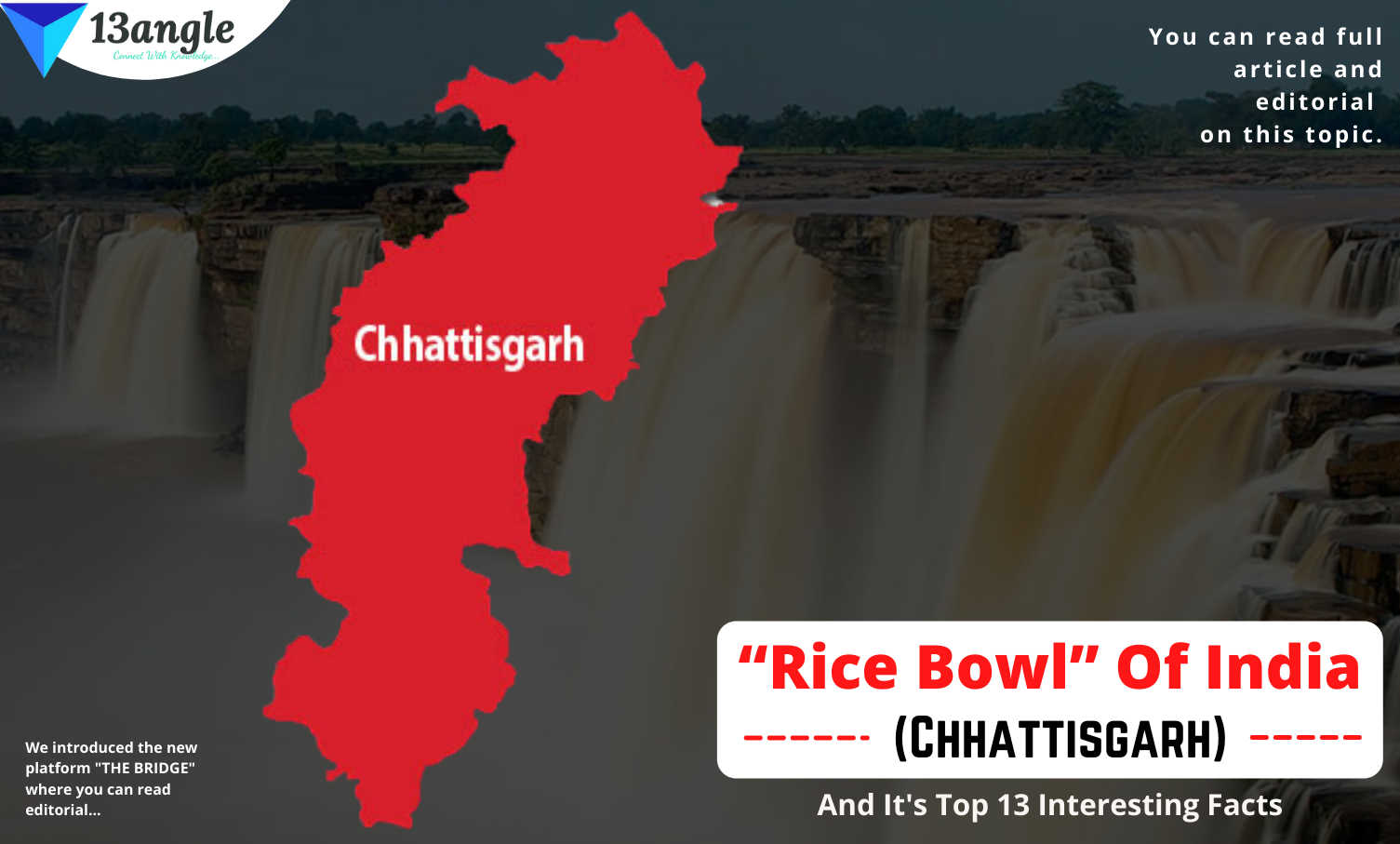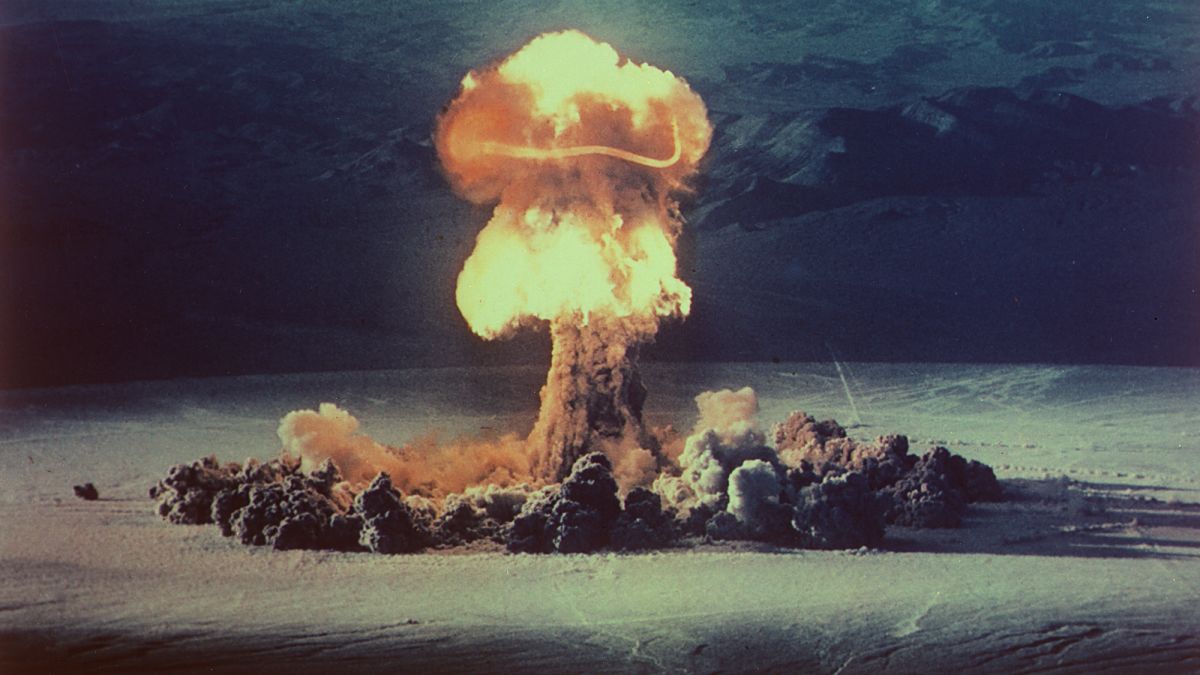
Introduction
- In the year 1998, from 11 to 13 May India conducted a series of nuclear explosions which were openly declared as India’s one of the most successful series of nuclear weapon tests. The nuclear test series in India consists of a pair of series popularly known as Pokhran I and Pokhran II. Pokhran I was a single nuclear test conducted in 1974.It took nearly around two-year of preparation for India to conduct these nuclear tests in Pokhran. Indira Gandhi, the former prime minister of India had authorized scientists at BARC to detonate an indigenously designed nuclear device in September 1972. The Pokhran-II tests was a series of five nuclear bomb test explosions conducted by India at the Indian Army’s Pokhran Test Range in May 1998. It was the second instance of nuclear testing conducted by India. Due to these test series India also faced lots of criticism and a series of sanctions from nations like the United States which was of the opinion that such tests will lead to nuclear proliferation in the world.
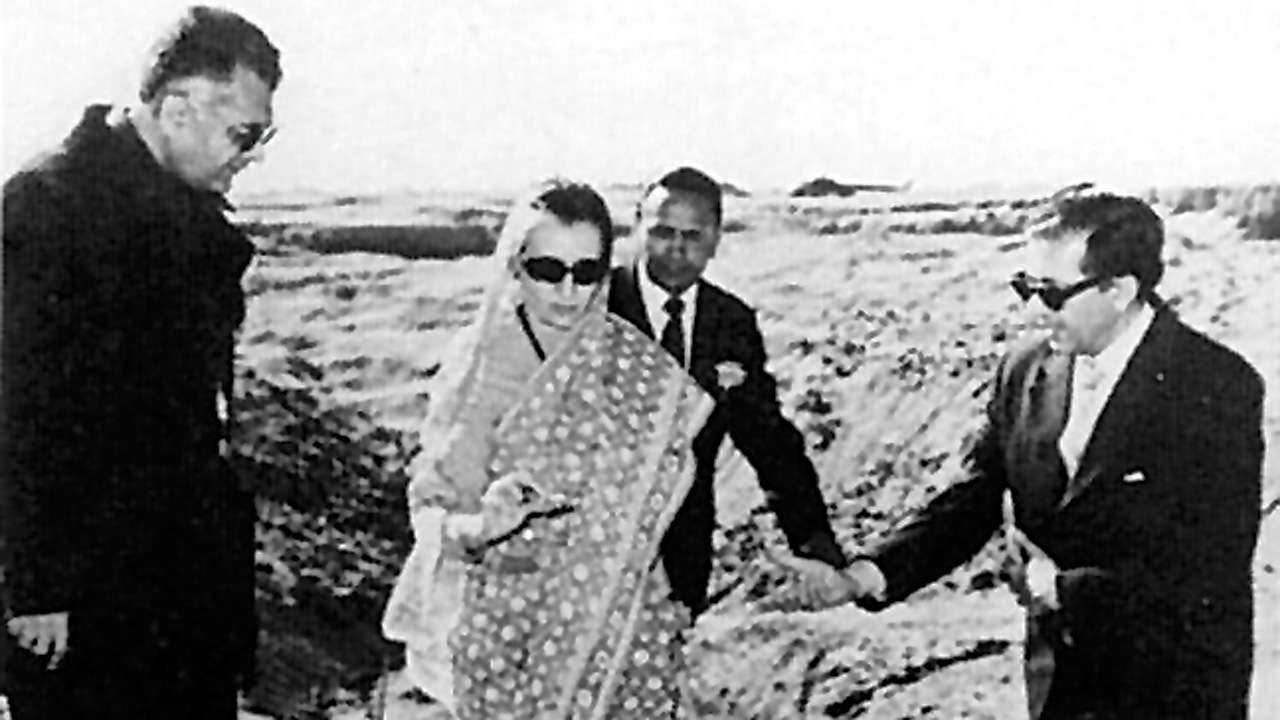
Historical Background
- The nuclear program in India had put a foot in 1944 when famous scientist Homi Bhabha tried to convince the Indian National Congress about the necessity of harnessing nuclear energy in a country like India which have billion of people to protect. To upheld this sector, in nineteen fifties rudimentary studies were done at BARC. Also, efforts regarding this were made to look for different ways to produce bomb components like plutonium with scarce resources and under the minimum budget of the government. With Indira Gandhi being the Prime Minister in 1966, more serious efforts were put forward to access such nuclear programs. Along with her the Physicist Raja Ramanna also played a very important role in steering this nuclear program in the right direction. As a result, the first nuclear tests by India were conducted in the year 1974 under the prime ministership of Indira Gandhi, this test was codenamed as ‘Smiling Buddha’. After these tests, the Nuclear Suppliers Group and the major nuclear powers of the world imposed technological apartheid on India.
Due to which India’s nuclear program slowed down a bit as the resources were not enough and the technology was also not as high-tech as it was required. This however was overcome in the year 1995, when the new Prime Minister Narasimha Rao decided to conduct further tests. When American satellites got to know about such impending tests in India they started pressurizing India to not do such tests.
Further with the change in the political party when A.B. Vajpayee became the Prime Minister, he made a move towards exercising the nuclear option in India as he declared in one of his speeches, “There will be made no compromise on national security, all options including the nuclear options will be exercised to ensure security and sovereignty in the nation”. This was further taken to the next level by the Scientist and the President of the country when APJ Abdul Kalam was appointed as the head of the missile program. Shri A.B.Vajpayee held a discussion and consulted with Dr. Kalam and R. Chidambaram who was the head of the nuclear weapons program about the nuclear test as these tests were to be conducted very discreetly. Therefore, to complete this task the Army’s 58th Engineer Regiment was entrusted with preparing the sites for testing without getting detected by the American spy satellites who were keeping an eye on every country’s explosive activity.
Nuclear Bomb Research, Preparation, Design And Development Team
Research For The Nuclear Test In India:-
Efforts towards building the nuclear bomb’s infrastructure and research on related technologies have been undertaken by India since World War II. The origins of India’s nuclear program date back to 1944 when nuclear physicist Homi Bhabha began persuading the Indian Congress Party towards the harnessing of nuclear energy— a year later to which he established the Tata Institute of Fundamental Research commonly known as TIFR.
In the 1950s, the preliminary studies were carried out at the BARC and the plans were developed to produce plutonium and other bomb components. In 1962, when India and China engaged in the disputed northern front and were further intimidated by a Chinese nuclear test in 1964, the need for a nuclear weapon was felt. However, the direction towards militarization of the nuclear program slowed down when Vikram Sarabhai became the head and Lal Bahadur Shastri showed very little interest after becoming the Prime Minister in that year.
But when Indira Gandhi became the Prime Minister in 1966, the nuclear program was consolidated and physicist Raja Ramanna joined the efforts. Another nuclear test conducted by China eventually led India’s decision to build nuclear weapons in 1967 and hence conducting its first nuclear test ‘Smiling Buddha’, in 1974.
Preparation And How It Was Held Secretly:-
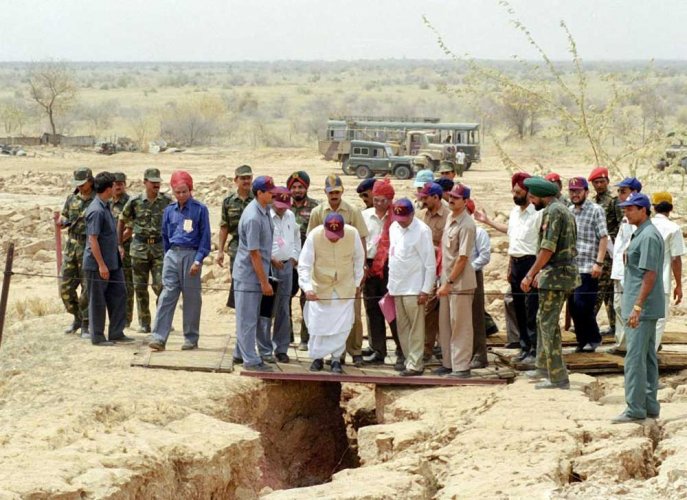
Three laboratories of the DRDO were involved in designing, testing and producing the components for the bombs including the advanced detonators, the implosion and high-voltage trigger systems. These were also responsible for weaponizing, systems engineering, aerodynamics, safety interlocks and flight trials. The bombs were transported in Indian Army trucks under the command of Colonel Umang Kapur.
All such devices from BARC were relocated at 3 am on 1 May 1998. From the Chhatrapati Shivaji International Airport, the bombs were flown in an Indian Air Force’s AN-32 commanded by Squadron Leader Mahendra Prasad Sharma plane to Jaisalmer. They were transported to Pokhran in an army convoy of four trucks which required three trips to transport all the devices and the necessary items. The devices were delivered to the device preparation building which was designated as ‘Prayer Hall’ to avoid any suspicion. All these devices were weapons-grade plutonium.
The test sites were organized into two government groups and were fired separately with all devices in a group fired at the same time. The first bomb was a fusion bomb and the rest were all fission bombs. Therefore, the first group consisted of the thermonuclear device (Shakti I), the fission device (Shakti II), and a sub-kiloton device (Shakti III). The second group consisted of the remaining two sub-kiloton devices Shakti IV and V. It was decided that the first group would be tested on 11 May and the second group on 13 May. The thermonuclear device was placed in a shaft code named ‘White House’, which was over 200 meters (660 ft) deep, the fission bomb was placed in a 150 meters (490 ft) deep shaft with the codename ‘Taj Mahal’, and the first sub-kiloton device in code named as ‘Kumbhkaran’. The first three devices were placed in their respective shafts on 10 May, and the first device to be placed was the sub-kiloton device in the ‘Kumbhkaran’ shaft which was sealed by the army engineers by 8:30 pm. The thermonuclear device was lowered and sealed into the ‘White House’ shaft by 4 am and then the fission device was placed in the ‘Taj Mahal’ shaft and was sealed at 7:30 am which was 90 minutes before the planned test time. The shafts were L-shaped along with a horizontal chamber for the test device.
The timing of the tests was basically depended on the local weather conditions with the wind being the critical factor. They were underground tests done in the deserts of Rajasthan due to a number of shaft seal failures that had occurred during tests conducted by the United States, the Soviet Union, and the United Kingdom, the sealing of the shaft could not be guaranteed to be leak-proof. By early afternoon, the winds had died down and the test sequence was initiated. Dr. K. Santhanam of the DRDO, in charge of the test site preparations gave two keys that activated the test countdown to Dr. M. Vasudev, the range safety officer-in-charge, who was responsible for verifying that all the test indicators were normal. After checking the indicators, Vasudev handed the keys to the representative of BARC and the DRDO, who unlocked the countdown system together.
During the mission, to avoid any doubt the head-in-charge were given the codename and were designated by that codename during the mission due to which Abdul Kalam’s name was switched with Major General Prithvi Raj and Rajagopala Chidambaram’s codename was “Natraj”. The engineer regiment had learnt to avoid any probe by the satellites by working in the cover of the night and by returning the equipment in its original place to give an impression that they were not moved. As these five nuclear tests were named Shakti-I and so on till Shakti-V this operation was called Operation Shakti.
Team Members And Institutions Involved
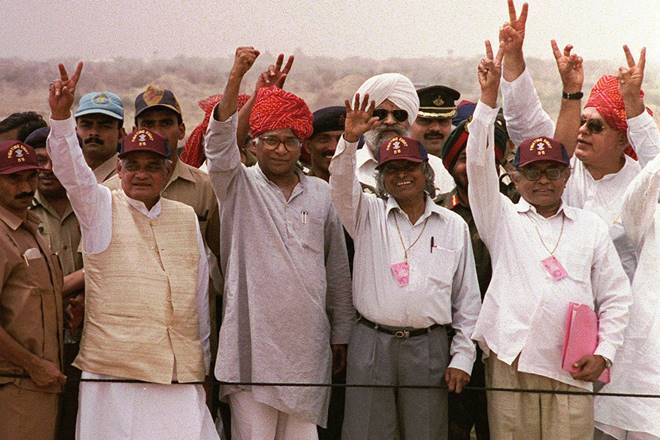
A small group of senior military officers, scientists and top-level politicians were only involved in the event’s planning with the chief coordinators Dr. Abdul Kalam and R Chidambaram.
Institutions like BARC, DRDO and the Atomic Minerals Directorate for Exploration and Research (AMDER) were involved.
=> The chief technical people involved with their designations at the time of the tests are given below:-
| S.N | Name | Institutions | Designations |
| 1 | APJ Abdul Kalam | DRDO | DRDO Head & Chief Scientific Advisor to the PM |
| 2 | R. Chidambaram | BARC | Chairman, Atomic Energy Commission & DAE |
| 3 | K Santhanam | DRDO | Officer-in-charge |
| 4 | G. R. Dikshitulu | AMDER | Officer-in-charge |
| 5 | Anil Kakodkar | BARC | Director |
Pokhran I
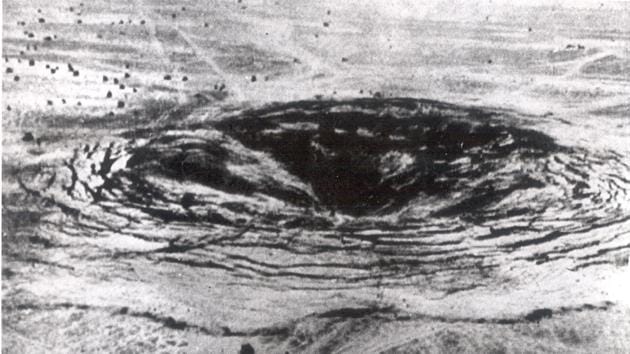
‘Smiling Buddha’ (commonly known as Pokhran-I) was the assigned code name of India’s first successful nuclear bomb test. On the 18th of May in the year 1974, the Indian government conducted its first-ever nuclear test in the deserts of Pokhran, Rajasthan. It was a peaceful nuclear explosion and with this India became the world’s sixth nuclear power country after the United States, Soviet Union, Britain, France, and China successfully test out a nuclear bomb. The name ‘Smiling Buddha’ was chosen because the test was conducted on the day of Buddha Purnima that year. It is told that Raja Ramanna, who was the director of India’s premier nuclear research institute Bhabha Atomic Research Centre (BARC) at that time conveyed the success of the nuclear test to Prime Minister Indira Gandhi by stating that “The Buddha has finally smiled”. This test was extra special for India because it was recorded as the first confirmed nuclear test by a nation that was not a permanent member of the United Nations Security Council (UNSC).
Though the yield of the device detonated at Pokhran is debated, the experts believed that the actual yield was around 8-12 Kilotons of TNT.
The Bhabha Atomic Research Centre had presented Kalam with a memento of a banyan tree bonsai which had a statue of a smiling Buddha under it. “The Buddha has smiled” was the code used by scientists in 1974 to declare that the nuclear test has been successful.
Pokhran-II Tests
After 1974, India again did the nuclear tests at the same location in which the first test was done which is commonly known as Pokhran-I tests or Smiling Buddha in 1998 when Atal Bihari Vajpayee was the prime minister. This test was a series of five nuclear explosions, in May 1998 at Pokhran.. Pokhran II was a milestone in India’s nuclear history.
Pokhran-II consisted of five detonations, the first of which was a fusion bomb while the remaining four were fission bombs. The tests were initiated on 11 May 1998, under the assigned code name Operation Shakti, with the detonation of one fusion and two fission bombs. On 13 May 1998, two additional fission devices were detonated, and the Indian government led by Prime Minister Atal Bihari Vajpayee shortly convened a press conference to declare India as a full-fledged nuclear state. The tests resulted in a variety of sanctions against India by a number of major states, including Japan and the United States. This 1998 test series consisted of a number of underground explosions at the Pokhran test site. According to India, one of these tests was the successful detonation of a thermonuclear weapon – a claim which was being challenged by outside scientists on the basis of the relatively low yield measured by seismic stations (as the first stations of the CTBTO’s International Monitoring System were still under construction at the time).
Many names have been assigned to these tests; originally these were collectively called Operation Shakti–98, and the five nuclear bombs were designated Shakti-I through to Shakti-V. More recently, the operation as a whole has come to be known as Pokhran II, and the 1974 explosion as Pokhran-I.
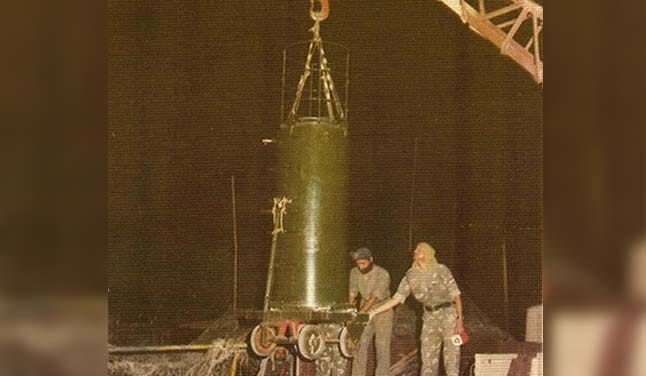
These tests achieved their main objective of giving India the capability to build fission and thermonuclear weapons with yields up to 200 kilotons. The then-Chairman of the Indian Atomic Energy Commission described each one of the explosions of Pokhran-II to be “equivalent to several tests carried out by other nuclear-weapon states over decades”.Subsequently, India established the computer-based simulation capability to predict the yields of nuclear explosives whose designs are related to the designs of explosives used in this test. Hence we celebrate 11 May as the National Technology Day as a reminder of the anniversary of the Pokhran-II tests.
However, prior to these 1974 and 1998 nuclear tests, India had spearheaded the movement to ban nuclear testing. But then in 1954, Indian Prime Minister Jawaharlal Nehru proposed a nuclear “standstill” agreement which was also the first milestone for nuclear arms control and hence reached with the 1963 Partial Test Ban Treaty, which limited nuclear testing to the underground. After the operation of 1996 CTBT, which was opened for signature in 1996 banned all forms of nuclear testing in the world. Out of which there were 44 countries that have to ratify this Treaty for its entry to make it come into force whereas 36 have already done the needful from this the remaining eight which were China, Egypt, Iran, Israel, and the United States had already signed the treaty. In this, the only remaining countries were India, Pakistan, along with the Democratic People’s Republic of Korea, which were yet to both sign and ratify the CTBT. Therefore these three were the only countries to have conducted the nuclear tests and broken the de-facto moratorium in place since the CTBT’s was held open for signature.
Reaction To The Test
1. Canada
The Canadian government, like the US, was very surprised and reacted sharply to the Indian nuclear test of May 1974. As the plutonium used in the nuclear device was produced by the Canadian aided nuclear reactor—CIRUS. Earlier the Indian officials had repeatedly assured Canada that the government did not intend to explode a nuclear device. Therefore, Canadian Prime Minister Trudeau had warned Mrs. Gandhi that in the happening of any nuclear test conducted by India, Canada would cut off all its nuclear cooperation as well as all economic aid.
However, after the test, Canada was satisfied with the fact that India had not violated any agreement between the two countries. But the secretary of state for external affairs stated that the nuclear test by India had put back the efforts of many years by other countries to prevent all nuclear testing and proliferation of nuclear weapons. However, India did not accept this view and stated the same by saying that the test was done by keeping in mind the maintenance of the peaceful nature of the nuclear explosion and declared that they had no intention to go in for nuclear weapons war.
But Trudeau worked vigorously to carry out his initial threat by cutting off all nuclear cooperation with India since then. Which was seen by the late 1970s, as serious setbacks in Indian nuclear energy development were evident after that. Of the many factors, Canada’s withdrawal of nuclear cooperation was cited as one of the biggest disadvantages which India had to suffer due to the nuclear test. Hence forcing India to adopt the policy of self-reliance in nuclear energy development.
2. America
The US was also caught by surprise by the Indian nuclear test, even after having the knowledge that India possessed the capability to produce such nuclear weapons. They were particularly at the Congressional level and were very upset with the proliferation taken place despite the nuclear Non-Proliferation Treaty (NPT) which came into force in the year 1970. US Secretary of State Henry Kissinger, who was fully in charge of US foreign policy at that time responded mildly because of Nixon’s involvement in Watergate this was the only reason why the US response was considered mild in comparison to the Canadian one. However, Dennis Kux who worked in the State Department stated that he after analyzing all the aspects of the US policy drafted a stronger protest. But Henry Kissinger, who was in charge of all foreign policy disagree on this and
hence a milder criticism was made. Kissinger further argued that since the explosion was an accomplished task and “public scolding would not undo the event”. One of the biggest reasons for this support from Kissinger was so because he was concerned about the possible reduction of US influence over the Indian nuclear policy, thus affecting the US-India relations during the Cold War. He also made it clear that he did not believe that this altered the balance of power in the region.
Beyond these public responses, the US cut off all its economic aids and introduced more stringent regulations in order to cover future nuclear cooperation between the US and other states. The US Congress, therefore, passed the Nuclear Non-Proliferation Act (NNPA) of 1978 which along with other countries demanded strict adherence to the international safeguards prescribed by the IAEA. It also made supply of enriched uranium for the Tarapur nuclear plant initially difficult which was later during Mrs. Gandhi’s visit to Washington, DC, France replaced the US by an agreement and further became the supplier of enriched uranium for the Tarapur plant.
But along with all these the Americans were becoming more concerned day by day about the Indian nuclear capability, especially after China became the first Asian state to possess nuclear weapons. The US also shared its concerns regarding this with Canada, particularly regarding its fear of plutonium extracted from CIRUS spent fuel which was being used for developing atomic weapons.
3. Pakistan
The most vehement and strong reaction to India’s nuclear explosion was from a neighboring country, Pakistan. Great ire was raised in Pakistan, which issued a severe statement blaming India for instigating a nuclear arms race in the region. That time Prime Minister Nawaz Sharif vowed that his country would give a suitable reply to India and hence the day after the first tests by India, the Foreign Minister of Pakistan Gohar Ayub Khan declared that Pakistan was ready to conduct a nuclear test.
This was even surprising for the world as Prime Minister Nawaz Sharif authorized an instant nuclear testing program and the Pakistan Atomic Energy Commission (PAEC) carried out their nuclear testing under the codename Chagai-I on 28 May 1998 and Chagai-II on 30 May 1998. These six underground nuclear tests at the Chagai and Kharan test sites were conducted fifteen days immediately after India’s conducted its last nuclear test in 1998. The total yield of the tests was reported to be 40 kt. With these tests of 1998, Pakistan gave Islamabad-Rawalpindi a sense of a ‘threshold’ below which they could continue to wage a proxy war, most spectacularly during Kargil.
Since then, Pakistan has taken the riskier path by developing tactical nuclear weapons as according to Pakistan’s science community, the Indian nuclear tests gave an opportunity to Pakistan to conduct nuclear tests after 14 years of conducting only cold tests, whereas India separated its civil and military programs and put a nuclear doctrine in place.
Pakistan’s subsequent tests invited similar condemnation from the United States as American President Bill Clinton quoted and said that “Two wrongs don’t make a right” hence criticizing Pakistan’s tests as reactionary to India’s Pokhran-II. The United States and Japan reacted on this matter further by imposing economic sanctions on Pakistan.
4. China
On 12 May the Chinese Foreign Ministry reacted to this news by stating that “The Chinese government is seriously concerned about the nuclear tests conducted by India,” and that the tests “run counter to the current international trend which is not promoting the peace and stability in South Asia.”. The next day the Chinese Foreign Ministry issued the statement clearly stating that “it is a shock and should be strongly condemned the test done by India. It further called for a meeting of the international community to adopt a unified stand and to strong demand from India to immediately stop their development in terms of nuclear weapons.
China further rejected India’s stated rationale of needing nuclear capabilities to counter a Chinese threat as “totally unreasonable”. In a meeting with Masayoshi Takemura of the Democratic Party of Japan, Foreign Minister of the People’s Republic of China, Qian Qichen quoted his point by saying that India’s nuclear tests are a “serious matter” particularly because they have been conducted while Knowing the fact that more than 140 countries have signed the Comprehensive Test Ban Treaty and further it is even more unacceptable because India claims to have conducted this tests to counter what they called a “China threat”.
Along with the strong criticism which was drawn by Canada on India’s actions and its High Commissioner. Sanctions were also imposed on India by other countries like Japan and it consisted of freezing all new loans and grants except for humanitarian aid to India. Further other nations also imposed sanctions on India, primarily in the form of suspension of foreign aid to India and government-to-government credit lines. However, the United Kingdom, France, and Russia refrained from condemning India in any way which was a big relief for India.
Movie And Documentary Based On The Nuclear Test Of India
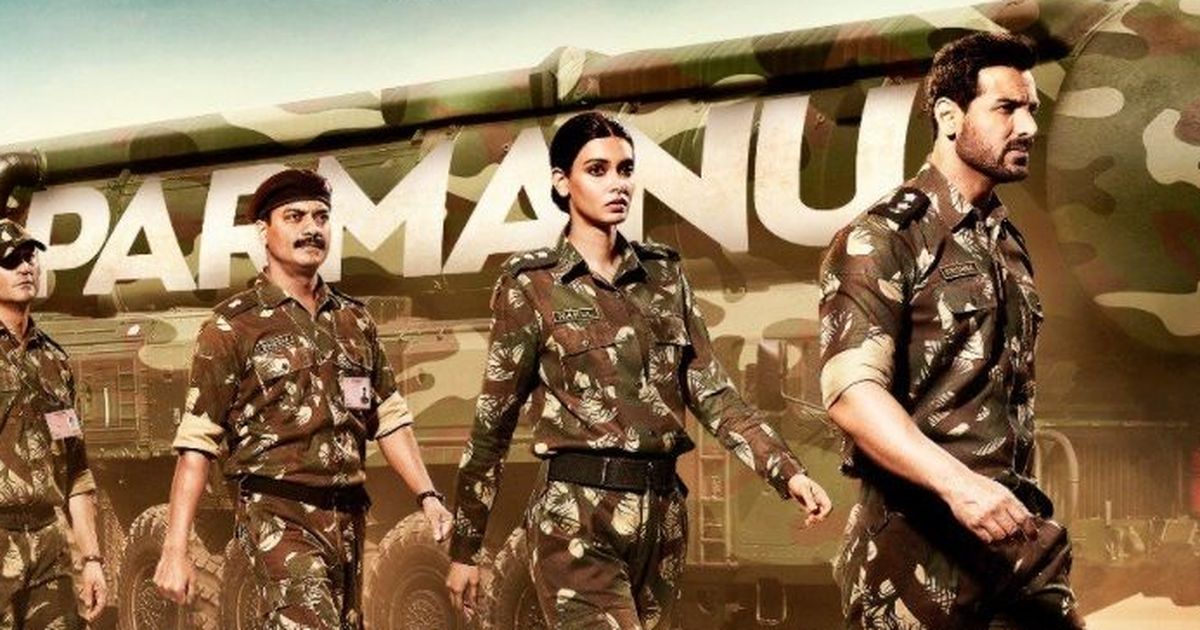
- Parmanu: The Story of Pokhran was a 2018 Indian period drama action film directed by Abhishek Sharma which was actually based on the nuclear bomb test explosions conducted by the Indian Army at Pokhran in 1998. It starred actors such as John Abraham, Diana Penty and Boman Irani in the lead roles. The basic ideology of this film was to depict that Parmanu is an ode to the Army and scientists, who although were ordinary people but they accomplished an extraordinary feats in the face of adversity to ensure that India finds its due place on the world nuclear map.
Documentary Film
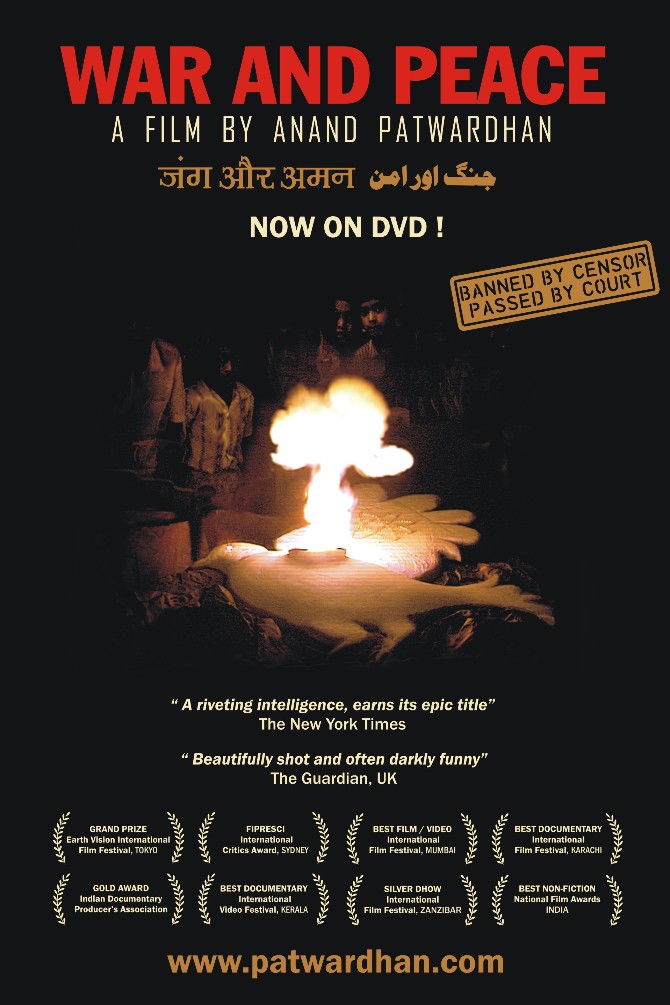
War and Peace (literal translation of which was Jang Aur Aman) is a 2002 Indian documentary film which was been directed by the famous director Anand Patwardhan. This film covers all the Indian and Pakistani nuclear weapons tests in 1998, as well as the nationalist rhetoric that accompanied these tests. It also explores the after-effect areas of the Indian test on the surrounding population and the reactions to the test among the government and the public. The latter part of the film also covers the perception of nuclear weapons in Japan and the United States. This film got many awards in respect of the content and theme of the documentary.
The awards such as the Best Documentary film in 2003, International Video Festival in Kerala 2004,the National Film Award for Best Non-Feature Film, India
International Film Critics’ Award (FIPRESCI) in the year 2002 , the Sydney Film Festival
Best Documentary in 2003 and Karachi International Film Festival
Gold Award by Indian Documentary Producer’s Association in 2002 and many more like that.
Top 13 Interesting Facts
The Indian government has officially declared 11 May as National Technology Day in India to commemorate the first of the five nuclear tests that were carried out on 11 May 1998.
The test was named ‘Smiling Buddha’ because it was conducted on Buddha Purnima that year.
With the Pokhran test, India became the first country outside the five permanent United Nations Security Council (UNSC) members to conduct the test.
The key highlight of the test was that India managed to avoid detection by the United States and other intelligence agencies.
the yield of the device detonated at Pokhran, experts maintained that the actual yield was around 8-12 Kilotons of TNT.
The test happened months after then foreign secretary K Raghunath told his US counterpart that India did not have any intention of testing a nuclear device.
Officially, the Indian Ministry of External Affairs (MEA) claimed that the Pokhran test was a “peaceful nuclear explosion”, but it was actually part of an accelerated nuclear weapons program.
Pokhran Trial 1 was conducted in utmost secrecy; Apart from Indira Gandhi, only two of her advisors, Parameshwara Haksar and Durga Dhar were informed. Scholar Raj Chengappa claims that Indian Defense Minister Jagjivan Ram was not informed about the test and came to know about it only after it was conducted.
The device exploded when Dastidar pressed the firing button at 8.05 am; It was in a 107 m shaft under the Army Pokhran test range in the Thar Desert (or Great Indian Desert), Rajasthan. The coordinates of the crater are 27.095°N 71.753°E.
The fully assembled device had a hexagonal cross-section, 1.25 m in diameter, and weighed 1400 kg. The device was mounted on a hexagonal metal tripod and moved to a shaft on a rail that the military had covered with sand.
The Indira Gandhi administration employed no more than 75 civilian scientists, while General G .G. Bewoor, the Indian Army chief and the commander of the Indian Western Command, was the only military commander to be informed.
The device was of an implant-type design and was very similar to the American atomic bomb known as Fat Man.
The 6 kg plutonium came from BARC’s CIRUS reactor. The neutron initiator was of the polonium-beryllium type and code-named flower. The entire atomic bomb was engineered and finally assembled by Indian engineers in Trombay before being taken to the test site.
Some FAQs Or Also Ask Question
Who led the Pokhran test in 1998 ?
On 13 May 1998, two additional fission devices were detonated, and the Indian government, led by Prime Minister Atal Bihari Vajpayee, shortly called a press conference to declare India a full-fledged nuclear state.
Who conducted the Pokhran nuclear test ?
India conducted the Pokhran nuclear test two times one in 1974 with a code name smiling Buddha and second time in 1998 with the code name operation shakti.
Who is the real hero of Pokhran2 ?
All the members such as the army, scientists, etc associated with the test of Pokhran test are the real heroes. Bharat Ratan Dr. APJ Abdul Kalam was head of the mission Pokhran 2.
Was Pokhran test successful ?
Pokhran 1 also known as operation smiling Buddha was partially successful while Pokhran 2 was successful.
How many nuclear tests done by India in Pokhran2 ?
The Pokhran-II tests were a series of five nuclear bomb test detonations conducted by India at the Pokhran Test Range of the Indian Army in May 1998.
